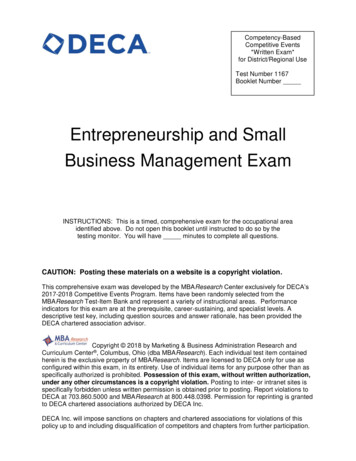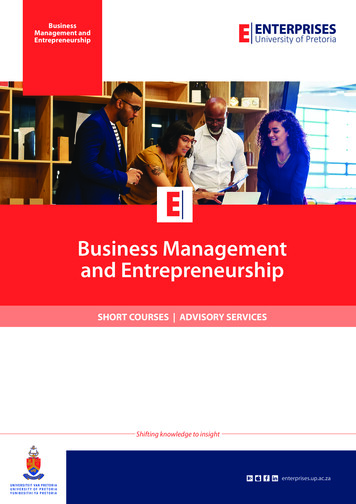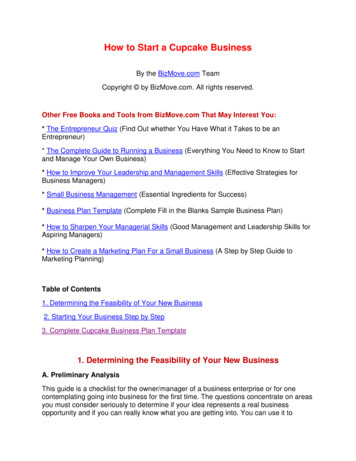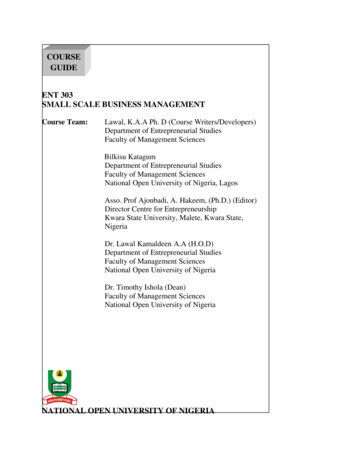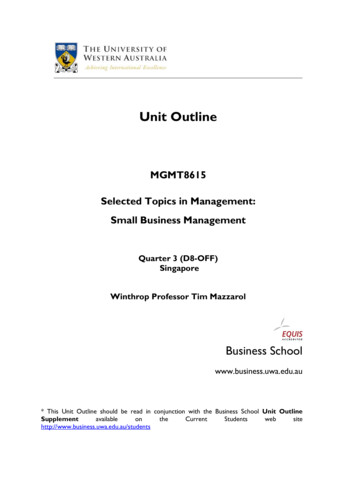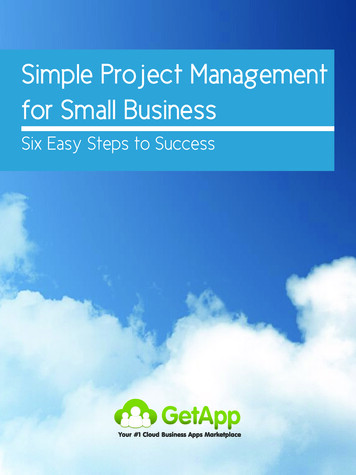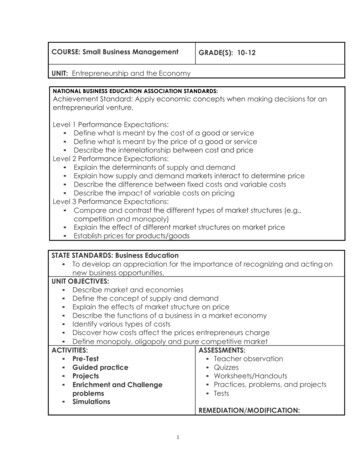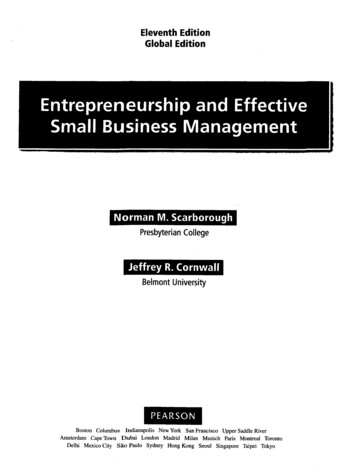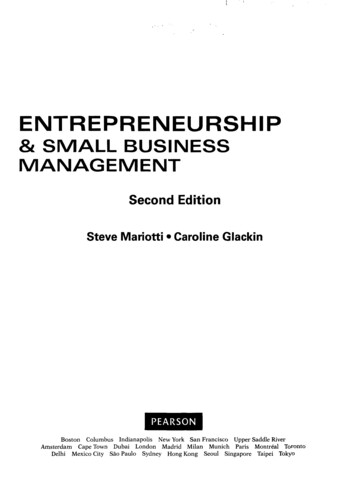
Transcription
ENTREPRENEURSHIP& SMALLBUSINESSMANAGEMENTSecond EditionSteve Mariotti Caroline GlackinPEARSONBoston Columbus Indianapolis New York San Francisco Upper Saddle RiverAmsterdam Cape Town Dubai London Madrid Milan Munich Paris Montreal TorontoDelhi Mexico City Säo Paulo Sydney Hong Kong Seoul Singapore Taipei Tokyo
ContentsUNIT 1Chapter 1Entrepreneurial PathwaysMaking the Business Work Personallyand Professional 23A Business Must Make a Profit to Stayin Business 23Profit Is the Sign That the EntrepreneurIs Adding Value 23Profit Results from the Entrepreneur'sChoices 23Seven Rules for Building a SuccessfulBusiness 24The Team Approach 241Entrepreneurs RecognizeOpportunities 2Entrepreneurship Defined 3What Is an Entrepreneur? 3The Economic Questions 4Voluntary Exchange 5Benefits and Challenges of Free Enterprise !What Is a Small Business? 6Why Become an Entrepreneur? 6The Desire to Make Money Is Not theOnly Reason to Start a Business 8Definitions of Success—Monetaryand Other 8Taking the Long View 9Chapter 2Benefits and Costs of Becomingan Entrepreneur 9Cost/Benefit Analysis 10Opportunity Cost 11Seeking Advice and InformationtoSucceed 11Entrepreneurial Options 13How Do Entrepreneurs Find Opportunitiesto Start New Businesses? 15Entrepreneurs Creatively Exploit Changes inOur World 15Where Others See Problems,Entrepreneurs Recognize Opportunities 16Train Your Mind to Recognize BusinessOpportunities 16Entrepreneurs Use Their Imaginations 17An Idea Is Not Necessarily anOpportunity 17Opportunity Is Situational 18The Five Roots of Opportunity in theMarketplace 18Integrating Internal and ExternalOpportunities 18Establishing Strategies 19Raths to Small Business Ownership 20Securing Franchise Rights 20Buying an Existing Business 20Licensing Technology 21Do Not Take Unfair Advantage of SomeoneElse s Creativity 21The Many Faces of Entrepreneurship 22Franchising 34Defining Franchising 35What Are the Types of Franchises? 35Positive Aspects of Franchises 37Start-Up Assistance 37Instant Recognition 38Purchasing Power 38Advertising and Promotional Support 38Operating Guidelines and Assistance 39Record of Success 40Drawbacks of Buying a Franchise 40Constraints on Creativity and Freedom 40Costs 41Standards and Termination 42The Structure of the Franchise Industry 42Franchising and the Law 43Steps for Franchise Selection 45Exploring Global FranchisingOpportunities 47Chapter 3Rinding Opportunity in an ExistingBusiness 56Reasons to Buy an Existing Business 58Quicker, Easier Start-Up 58Reduced Risk 58Bargain Potential 59Your Knowledge Can Be Beneficial 59Potential Pitfalls of Buying an ExistingBusiness 59Investment Requirements 60Buying Someone Eise's Problems 60Business Is Not a Good Fit 61Finding and Evaluating AvailableBusinesses 61v
CONTENTSviSources of Existing Businesses 61Due Diligence—Reality versus the Story 62Determining the Value of a Business64Negotiating and Closing a Purchase 66Buying into a Business over Time 66Family Business as an EntrepreneurialOpportunity 66Chapter 4jjUnit 1 Entrepreneurial Pathways:SPANX-Idea to EntrepreneurialOpportunity 132UNIT 2Chapter 5137Creating Business fromOpportunity 138Apple and the Personal Computer 139The Business Plan: Road Mapto Success 74Business Definition 140What Sort of Organization DoYou Want? 141Your Company's Core Values 141Your Company's Mission Is to SatisfyCustomers 142Your Company's Vision Is the BroaderPerspective 143Your Company's Culture Defines theWork Environment 143The Decision Process 144Feasibility Analysis: Does My IdeaWork? 75Analyzing Product and/or ServiceFeasibility 76Analyzing Market and IndustryFeasibility 77Analyzing Financial Feasibility 79Creating a Business Model Canvas 80What Is a Business Plan? 83Why Do You Need a Business Plan? 84Writing a Business Plan Early Will SaveYou Time and Money 84Your Business Plan Is the Key to RaisingCapital 85The Business Plan Is an Operations Guide 85Business Plan Components 85Cover Page and Table of Contents 86Executive Summary: A Snapshot ofYour Business 86Mission, Vision and Culture 87Company Description:Background and Track Record 88Opportunity Analysis and Research:Testing Ideas 88Marketing Strategy and Plan:Reaching Customers 89Managementand Operations:Making the Plan Happen 90Financial Analysis and Projections:Translating Action into Money 91Funding Request and Exit Strategy:The Ask and the Return 95Appendices: Making the Case inGreater Detail 96Business Plan Suggestions 96Presenting Your Business Plan 97Business Plan and VentureCompetitions 98Honest Tea Business PlanWho Are Your Customers?105Your Competitive Advantage 145Find Your Competitive Advantage byDetermining What Consumers Needand Want 146You Have Unique Knowledge ofYour Market 146The Six Factors of CompetitiveAdvantage 147Is Your Competitive Advantage StrongEnough? 147Checking Outthe Competition 148The Most Chocolate Cake Company 149Competitive Strategy: Business Definitionand Competitive Advantage 151Feasibility Revisited: The Economicsof One Unit as a Litmus Test 152Defining the Unit ofSale 153Cost of Goods Sold and Gross Profit 153Your Business and the Economics of OneUnit 154The Cost of Direct Labor in the EOU—An Example 156Hiring Othersto Make the UnitofSale 156Going for Volume 157Chapter 6Exploring Your Market168Markets and Marketing Defined 169A Business That Markets versusa Market-Driven Business 170
CONTENTSMarket and Marketing Research SupportSuccess 170Research Your Market Before You OpenYour Business 170Types and Methods of Research 171Gelting Information Directly fromthe Source:Primary Research 171Gotting Information Indirectly:Secondary Research 172Market Research Helps You KnowYourCustomer 173Customer Research 175Industry Research: The 50,000-FootPerspective 177Make Market Research an IntegralPart of Your Business 178How Customers Decide to Buy 179Owning a Perception in the Customer sMind 179Features Create Benefits 180Home Depot: Teaching Customers SoThey Will Return 180Which Segment of the MarketWill You Target? 181Successful Segmenting: The Body Shop 181Applying Market Segmentation Methods 182The Product Life Cycle 184Is Your Market Saturated? 185Market Positioning: Drive HomeYour Competitive Advantage 185Developing a Marketing Plan 186Unit 2 Opportunity Assessment:Kitchen Arts & Letters, Inc.—An Independent Bookstore DefiesIndustry Odds 195UNIT 3Chapter 7; Integrated Marketing199Developing the Right MarketingMix and Plan 200The Four Marketing Factors 201Product: What Are You Solling? 202Create Your Total Product or ServiceConcept 202Focus Your Brand 203Ford's Costly Failure: The Edsel 203Ford's Focus on Success: The Mustang 203How to Build Your Brand 204Price: What It Says about YourProduct 206VÜPlace: Location, Location, Location! 206Promotion: Advertising Publicity 207The Fifth P: Philanthropy 207Cause-Related Marketing 208Gaining Goodwill 208Not-for-Profit Organizations 209Teach for America and Upromise 209What Entrepreneurs Have Built 210You Have Something to Contribute 210Developing a Marketing Plan 210Marketing Analysis 211Marketing as a Fixed Cost 212Calculate Your Breakeven Point 212Chapter 8 Pricing and Credit Strategies 224 Pricing: Image, Value, and CompetitionTogether 225Strategies and Tactics for EffectivePricing 226Pricing Variesby the Type of Firm 229Pricing Techniques for Manufacturers 229Pricing Techniques for Wholesalers 230Pricing Techniques for Retailers 230Keystoning—The Retailer's RuleofThumb 231Pricing Techniques for ServiceBusinesses 232Pricing Principles 233Extending Credit to Customers 233The Costs and Benefits of Credit 233Types of Credit 233Credit's Impact on Pricing 235Managing the Credit Process 236Sources of Credit Information 237Aging of Receivables 237Credit Regulation 237Discounts, Incentives, and OtherPrice Adjustments 238Chapter 9Integrated MarketingCommunications 248Use Integrated Marketing Communicationsfor Success 249Reinforce the Company's Unique SellingProposition 249Promotional Flanning 250Create a Promotional Strategy UsingPromotions Opportunity Analysis 250Determine a Promotional Budget 252
CONTENTSThe Advertising Advantage 253Advertising Agencies and Freelancers 254Typ es of Advertising 255Media Flanning and Buying:Focus on Your Customer 256The Media 256Broadcast Media 257Print Media 258Outdoor Advertising (Out-of-HomeAdvertising) 260Advertising Measurement: Beyond Reachand Frequency 262Marketing Materials Should ReinforceYour Competitive Advantage 264Collateral Materials: Print andMultimedia 264Sales-Promotion Solutions 265When to Use Promotional Tools 265Advertising Specialties 265Trade Show Exhibits 266Mall Carts or Kiosks 266Alternative Marketing 267Other Media Venues 268Database and Direct-ResponseMarketing 269Data Collection, Coding, and Mining 269Marketing Communications Drivenby Databases 270E-Active Marketing 271Publicity Potential 274Generating Publicity 274Telling the Story 275Sample Press Release 276Follow Up a Press Release 276Public Relations 27610 Marketing GloballyI288Reasonsto Market Globally 289Market Expansion 290Access to Resources 292Cost Reduction 293Location-Specific Advantages 293Improving Quality Levels 294Strategy Options for Global VenturesImporting 294Exporting 295Strategie Alliances 299International Licensing 300International Franchising 301International Facilities 301294Challenges to International Trade 302Economic Risk 302Political Risk 303Organizational Capacity 303Legal and Regulatory Barriers 305Cultural and Ethnic Considerations 306Support for Global Ventures 307Market Research, Analysis, Flanning,and Readiness 307Customer and Partner Identificationand Relationship Building 308Financing 309Trade Agreements Influence GlobalMarketing 312Chapter 11 Smart Selling and EffectiveilJflPJSjCustomer Service 322Selling Skills Are Essential to BusinessSuccess 323Selling Is a Great Source of MarketResearch 324The Essence of Selling Is Teaching 324The Principles of Selling 324The Sales Call 326Electronic Mail, Blogs, and SocialNetworks 326Prequalify Your Sales Calls 327Focus on the Customer 327The Eight-Step Sales Call 328Three Call Behaviors of SuccessfulSalespeople 329Analyze Your Sales Calls to Becomea Star Salesperson 329Turning Objections into Advantages 330Use Technology to Seil 330Successful Businesses Need CustomersWho Return 332Customer Service Is Keeping CustomersHappy 332The Costs of Losing a Customer 332Customer Complaints Are Valuable 333Customer Relationship ManagementSystems 334Why Does CRM Matter? 335Components of CRM for the SmallBusiness 336How Technology Supports CRM 337Unit 3 Integrated Marketing:Empact—Making an Impactfor Entrepreneurs 346
CONTENTSUNIT 4Show Me the Money: Rinding,Securing, and Managing It349Chapter 12 Understanding and ManagingStart-Up, Fixed, and VariableCosts 350What Does It Cost to Operatea Business? 351Start-Up Investment 352Brainstorm to Avoid Start-Up Surprises 352Keep a Reserve Equalto One-Half theStart-Up Investment 353Predictthe Payback Period 354Estimate Value 355Fixed and Variable Costs: Essential BuildingBlocks 356Calculating Critical Costs 356Calculating Total Gross Profit(Contribution Margin) 357Calculating EOU When You Seil MultipleProducts 357Fixed Operating Costs 359Fixed Operating Costs Can ChangeOver Time 359Allocate Fixed Operating Costs WherePossible 360The Dangers of Fixed Costs 361Using Accounting Records to Track Fixedand Variable Costs 361Three Reasons to Keep Good RecordsEvery Day 361Cash versus Accrual Accounting Methods 364Recognizing Categories of Costs 364Chapter 13 Using Financial Statements to Guidea Business 374Scorecards for the Entrepreneur: WhatDo Financial Statements Show? 375Income Statements: Showing Profitand Loss Over Time 376Parts of an Income Statement 376A Basic Income Statement 377The Double Bottom Line 378An Income Statement for a More ComplexBusiness 378The Balance Sheet: A Snapshot of Assets,Liabilities, and Equity at a Pointin Time 380Short- and Long-Term Assets 382Current and Long-Term Liabilities 382ixThe Balance Sheet Equation 382The Balance Sheet Shows Assets andLiabilities Obtained through Financing 382The Balance Sheet Shows How a BusinessIs Financed 383Analyzing a Balance Sheet 384Depreciation 386Financial Ratio Analysis: What Is It andWhat Does ItMeanto You? 386Income Statement Ratios 386Balance-Sheet Analysis 389Chapter 14 Cash Flow and Taxes 410Cash Flow: The Lifebloodof a Business 411The Income Statement Does Not ShowAvailable Cash 411Rules to Keep Cash Flowing 413Noncash Expenses Can Distort the FinancialPicture 413The Working Capital Cycle 413The Cyclical and Seasonal Natureof Cash Flow 413Reading a Cash Flow Statement 416The Cash Flow Equation 416Forecasting Cash Flow:The Cash Budget 416Creating a Healthy Cash Flow 419Managing Inventoryto Manage Cash 419Managing Receivablesto ManageCash 421The Cash Effects of AccountsReceivable 421The Life Cycle of Accounts Receivable 421The Financing of Accounts Receivable 422Managing Accounts Payable to ManageCash 422Negotiating Payment 422Urning Payables 423Capital Budgeting and Cash Flow 423The Burn Rate 424The Value of Money Changes OverTime 425The Future Value of Money 425The Present Value of Money 426Taxes 428Cash Flow and Taxes 428Filing Tax Returns 428Collecting SalesTax 429
CONTENTSTax Issues for Different LegalStructures 429Make Tax Time Easier by KeepingGood Records 429Chapter 15 Financing Strategy: Debt, Equity,or Both? 440Going It Alone versus Securing-"*** Financing 441How Often Do Small Businesses ReallyFail? 442What Isthe Best Type of Financingfor You and Your Business? 442Gifts and Grants 443Debt Financing 444Debt Financing: Pros and Cons 444Equity Financing 446Equity Financing: Pros and Cons 446Where and How to Find Capital ThatWorks for You 447Having an Excellent Business Plan Goesa Long Way 450How Capital Sources Read Your BusinessPlan 450Family and Friends 450Financial Institutions and Dimensionsof Credit 450Community Development FinancialInstitutions (CDFIs) 452Venture Capitalists 453Angels 454Insurance Compan
ENTREPRENEURSHIP & SMALL BUSINESS MANAGEMENT Second Edition Steve Mariotti Caroline Glackin PEARSON Boston Columbus Indianapolis New York San Francisco Upper Saddle River Amsterdam Cape Town Dubai London Madrid Milan Munich Paris Montreal Toronto Delhi Mexico City Säo Paulo Sydney Hong Kong Seoul Singapore Taipei Tokyo . Contents UNIT 1 Entrepreneurial


